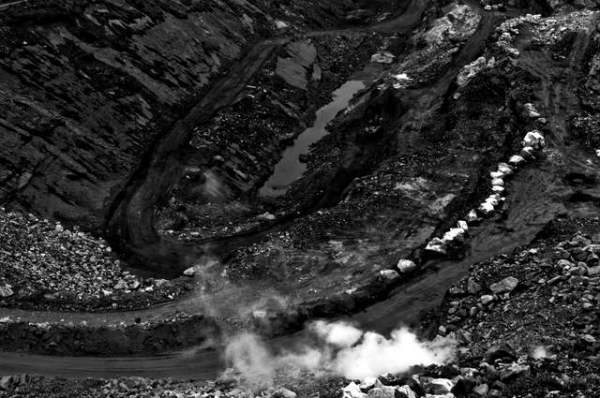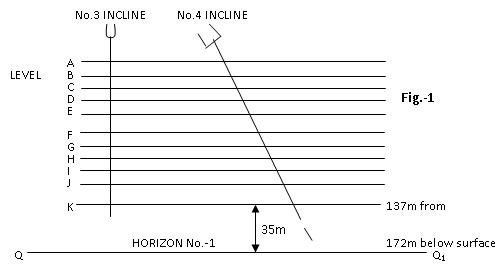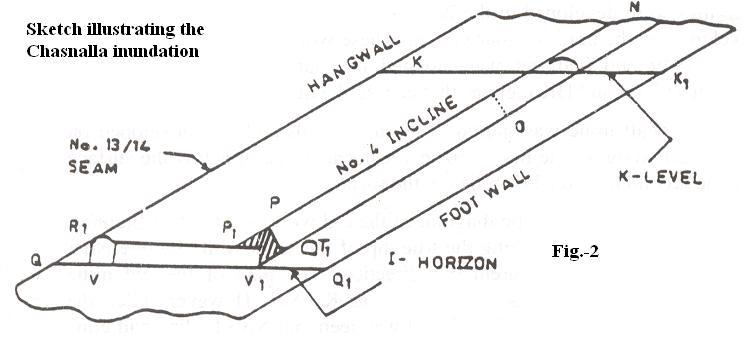You are here :
Home Chasnalla Colliery on 27.12.1975
|
Last Updated:: 02/06/2015
Chasnalla Colliery on 27.12.1975
Chasnalla Colliery
| Date of the Accident |
- 27.12.1975 |
| Number of persons killed |
- 375 |
| Owner |
- Indian Iron & Steel Co. Ltd. |
| Place |
- Jharia Coalfield |
In what has proved to be the worst-ever disaster in the history of mining in India, 375 coal miners were buried alive in the Chas Nala colliery in Bihar on December 26 when an 80 ft roof of coal between them and an adjoining waterlogged mine collapsed without warning. A shroud of mystery still surrounds the actual cause of the tragedy but according to officials of the Indian Iron and Steel Company, the firm that owns the mine, this should never have occurred since they conformed to international standards. Yet, a 120 sq ft hole in the roof did form, letting in an estimated seven million gallons of water per minute.

The lake that sank and killed 375 miners at Chasnala
(This has been the greatest mine disaster in India so far causing the highest number of deaths)
Inrush of a large volume of water into the 13/14 combined seam workings of the new deep shaft mine from old abandoned incline workings in the same seam. The 13/14 combined seam is about 24 m thick and has a gradient of 1 in 1.5. There is a major dyke running through the property and the old workings in the 13/14 combined seam on the west side are separated from the east side workings by this dyke. On the west side the seam was worked through four inclines, namely 1, 3 (old) ,2A and 2; and on the east side through three inclines, namely, 3, 4 and HK Inclines. Both these sets of workings were developed in the pattern of levels, the various levels being developed on the bord & pillar system. These workings were abandoned in April, 1949 and had got water-logged in course of time. It was the workings of 3, 4 and HK inclines that caused the disaster./p>
The deep shaft mine was started in the mid-1960s and was developed on the horizon system. The first horizon was located 172 m below the surface and the second horizon 291 m below the surface. Fig.-1 shows a schematic diagram of the old working of 3 & 4 Inclines. Incline No.3 was driven along the true dip of the seam while Incline No.4 was driven along an apparent dip direction. The plan of the old mine showed that the workings had stopped at K-level. However, after the accident and dewatering of the mine, it was seen that No.3 Incline had gone down to an inclined distance of about 6 m beyond K-level and No.4 incline had gone to an inclined distance of 49 m below K-level. Line QQ represents horizon No.1 of the new shaft workings.

The old workings were full of water from K-level to C-level and must have contained about 500,000 m3 of water. K-level had 118 m of head of water above it. The connection between the old workings and the new workings was made in horizon No.1 at the inbye end of 15 m long ventilation cross-cut being driven from the hangwall towards the footwall. Fig.2 shows the details.

NP represents Incline No.4, KK1 the K-level of old workings and QQ1 horizon No.1 in the new workings. R1 represents the hangwall gallery and VV1 the ventilation connection being driven at right angles to the hangwall gallery. PP1 represents the block of coal which had been dislodged from the base of No.4 Incline making the connection. (It may be noted that the end T1 of the foot wall drivage had already gone below the extension of No.4 Incline. The parting between the roof of the footwall drivage and floor of No.4 Incline at that place was only about 1.8 m. Fortunately no holing-through had occurred at that point).
The puncture was about 2 m wide by 3 to 4 m high. About 1, 35,000 m3 of water flowed into the new mine until horizons 1 and 2 were completely flooded and water had risen in the two shafts to find its own level and stabilize. In the process, water level in the old workings had fallen to E- level.
Later on, as water was pumped out from the deep mine through the shafts, the entire water of the old workings went down through the same connection until all of it had been pumped out.
Under the circumstances mentioned above, no one inside the deep mine at the time of the accident had any chance of survival. After the mine was dewatered, the first rescue team was sent down through Pit No.2 on 19.1.1976, that is, 23 days after the accident. As to the recovery of the bodies of the victims, only skeletons and bones could be taken out. The remains of some of the bodies could be identified by their cap-lamps, wearing apparel and/or by some materials like keys, knives, etc. However, most of them could not be identified because cap-lamps were not found attached to them. According to the opinion of the Reconciliation Committee, the number of bodies recovered was somewhere between 374 and 380. Therefore the Court had no reason to disagree with the figure of 375 persons as given by the management.